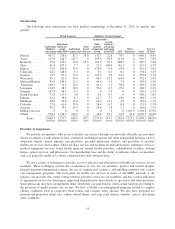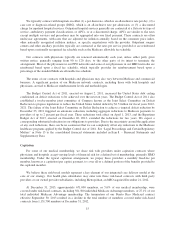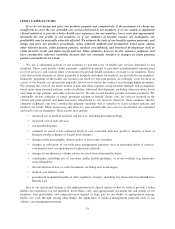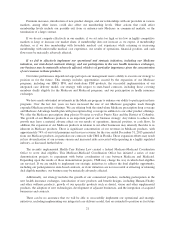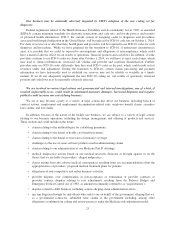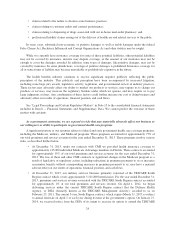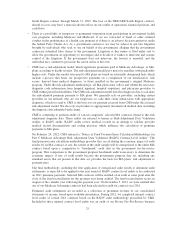Humana 2013 Annual Report Download - page 33
Download and view the complete annual report
Please find page 33 of the 2013 Humana annual report below. You can navigate through the pages in the report by either clicking on the pages listed below, or by using the keyword search tool below to find specific information within the annual report.Our business may be materially adversely impacted by CMS’s adoption of the new coding set for
diagnoses.
Federal regulations related to the Health Insurance Portability and Accountability Act of 1996, as amended
(HIPAA) contain minimum standards for electronic transactions and code sets, and for the privacy and security
of protected health information. ICD-9, the current system of assigning codes to diagnoses and procedures
associated with hospital utilization in the United States, will be replaced by ICD-10 code sets on October 1, 2014.
For dates of service on or after that date, health plans and providers will be required to use ICD-10 codes for such
diagnoses and procedures. While we have prepared for the transition to ICD-10, if unforeseen circumstances
arise, it is possible that we could be exposed to investigations and allegations of noncompliance, which could
have a material adverse effect on our results of operations, financial position and cash flows. In addition, if some
providers continue to use ICD-9 codes on claims after October 1, 2014, we will have to reject such claims, which
may lead to claim resubmissions, increased call volume and provider and customer dissatisfaction. Further,
providers may use ICD-10 codes differently than they used ICD-9 codes in the past, which could result in lost
revenues under risk adjustment. During the transition to ICD-10, certain claims processing and payment
information we have historically used to establish our reserves may not be reliable or available in a timely
manner. If we do not adequately implement the new ICD-10 coding set, our results of operations, financial
position and cash flows may be materially adversely affected.
We are involved in various legal actions and governmental and internal investigations, any of which, if
resolved unfavorably to us, could result in substantial monetary damages. Increased litigation and negative
publicity could increase our cost of doing business.
We are or may become a party to a variety of legal actions that affect our business, including breach of
contract actions, employment and employment discrimination-related suits, employee benefit claims, securities
laws claims, and tort claims.
In addition, because of the nature of the health care business, we are subject to a variety of legal actions
relating to our business operations, including the design, management, and offering of products and services.
These include and could include in the future:
• claims relating to the methodologies for calculating premiums;
• claims relating to the denial of health care benefit payments;
• claims relating to the denial or rescission of insurance coverage;
• challenges to the use of some software products used in administering claims;
• claims relating to our administration of our Medicare Part D offerings;
• medical malpractice actions based on our medical necessity decisions or brought against us on the
theory that we are liable for providers’ alleged malpractice;
• claims arising from any adverse medical consequences resulting from our recommendations about the
appropriateness of providers’ proposed medical treatment plans for patients;
• allegations of anti-competitive and unfair business activities;
• provider disputes over compensation or non-acceptance or termination of provider contracts or
provider contract disputes relating to rate adjustments resulting from the Balance Budget and
Emergency Deficit Control Act of 1985, as amended (commonly referred to as “sequestration”);
• disputes related to ASO business, including actions alleging claim administration errors;
• qui tam litigation brought by individuals who seek to sue on behalf of the government, alleging that we,
as a government contractor, submitted false claims to the government including, among other
allegations, resulting from coding and review practices under the Medicare risk-adjustment model;
23



